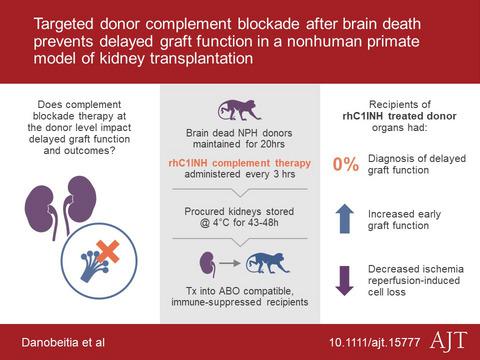当前位置:
X-MOL 学术
›
Am. J. Transplant.
›
论文详情
Our official English website, www.x-mol.net, welcomes your feedback! (Note: you will need to create a separate account there.)
Targeted donor complement blockade after brain death prevents delayed graft function in a nonhuman primate model of kidney transplantation.
American Journal of Transplantation ( IF 8.8 ) Pub Date : 2020-01-10 , DOI: 10.1111/ajt.15777 Juan S Danobeitia 1 , Tiffany J Zens 1 , Peter J Chlebeck 1 , Laura J Zitur 1 , Jose A Reyes 1 , Michael J Eerhart 1 , Jennifer Coonen 2 , Saverio Capuano 2 , Anthony M D'Alessandro 1 , Jose R Torrealba 3 , Daniel Burguete 3 , Kevin Brunner 2 , Edwin Van Amersfoort 4 , Yolanda Ponstein 4 , Cees Van Kooten 5 , Ewa Jankowska-Gan 1 , William Burlingham 1 , Jeremy Sullivan 1 , Arjang Djamali 6 , Myron Pozniak 7 , Yucel Yankol 1 , Luis A Fernandez 1
American Journal of Transplantation ( IF 8.8 ) Pub Date : 2020-01-10 , DOI: 10.1111/ajt.15777 Juan S Danobeitia 1 , Tiffany J Zens 1 , Peter J Chlebeck 1 , Laura J Zitur 1 , Jose A Reyes 1 , Michael J Eerhart 1 , Jennifer Coonen 2 , Saverio Capuano 2 , Anthony M D'Alessandro 1 , Jose R Torrealba 3 , Daniel Burguete 3 , Kevin Brunner 2 , Edwin Van Amersfoort 4 , Yolanda Ponstein 4 , Cees Van Kooten 5 , Ewa Jankowska-Gan 1 , William Burlingham 1 , Jeremy Sullivan 1 , Arjang Djamali 6 , Myron Pozniak 7 , Yucel Yankol 1 , Luis A Fernandez 1
Affiliation

|
Delayed graft function (DGF) in renal transplant is associated with reduced graft survival and increased immunogenicity. The complement-driven inflammatory response after brain death (BD) and posttransplant reperfusion injury play significant roles in the pathogenesis of DGF. In a nonhuman primate model, we tested complement-blockade in BD donors to prevent DGF and improve graft survival. BD donors were maintained for 20 hours; kidneys were procured and stored at 4°C for 43-48 hours prior to implantation into ABO-compatible, nonsensitized, MHC-mismatched recipients. Animals were divided into 3 donor-treatment groups: G1 - vehicle, G2 - rhC1INH+heparin, and G3 - heparin. G2 donors showed significant reduction in classical complement pathway activation and decreased levels of tumor necrosis factor α and monocyte chemoattractant protein 1. DGF was diagnosed in 4/6 (67%) G1 recipients, 3/3 (100%) G3 recipients, and 0/6 (0%) G2 recipients (P = .008). In addition, G2 recipients showed superior renal function, reduced sC5b-9, and reduced urinary neutrophil gelatinase-associated lipocalin in the first week posttransplant. We observed no differences in incidence or severity of graft rejection between groups. Collectively, the data indicate that donor-management targeting complement activation prevents the development of DGF. Our results suggest a pivotal role for complement activation in BD-induced renal injury and postulate complement blockade as a promising strategy for the prevention of DGF after transplantation.
中文翻译:

脑死亡后靶向供体补体阻断可防止非人灵长类动物肾移植模型中移植物功能延迟。
肾移植中移植物功能延迟 (DGF) 与移植物存活率降低和免疫原性增加有关。脑死亡 (BD) 和移植后再灌注损伤后补体驱动的炎症反应在 DGF 的发病机制中起重要作用。在非人灵长类动物模型中,我们在 BD 供体中测试了补体阻断以防止 DGF 并提高移植物存活率。BD供体维持20小时;在植入 ABO 兼容、未致敏、MHC 不匹配的接受者之前,采购肾脏并在 4°C 下储存 43-48 小时。动物被分为 3 个供体治疗组:G1 - 载体、G2 - rhC1INH+肝素和 G3 - 肝素。G2 供体显示经典补体途径激活显着减少,肿瘤坏死因子 α 和单核细胞趋化蛋白 1 水平降低。DGF 在 4/6 (67%) G1 受者、3/3 (100%) G3 受者和 0/6 (0%) G2 受者中被诊断出来 (P = .008)。此外,G2 受体在移植后第一周表现出更好的肾功能、sC5b-9 减少和尿液中性粒细胞明胶酶相关脂质运载蛋白减少。我们观察到组间移植物排斥的发生率或严重程度没有差异。总的来说,数据表明靶向补体激活的供体管理可防止 DGF 的发展。我们的结果表明补体激活在 BD 诱导的肾损伤中起关键作用,并假设补体阻断是移植后预防 DGF 的有前途的策略。移植后第一周尿中性粒细胞明胶酶相关脂质运载蛋白减少。我们观察到组间移植物排斥的发生率或严重程度没有差异。总的来说,数据表明靶向补体激活的供体管理可防止 DGF 的发展。我们的结果表明补体激活在 BD 诱导的肾损伤中起关键作用,并假设补体阻断是移植后预防 DGF 的有前途的策略。移植后第一周尿中性粒细胞明胶酶相关脂质运载蛋白减少。我们观察到组间移植物排斥的发生率或严重程度没有差异。总的来说,数据表明靶向补体激活的供体管理可防止 DGF 的发展。我们的结果表明补体激活在 BD 诱导的肾损伤中起关键作用,并假设补体阻断是移植后预防 DGF 的有前途的策略。
更新日期:2020-01-10
中文翻译:

脑死亡后靶向供体补体阻断可防止非人灵长类动物肾移植模型中移植物功能延迟。
肾移植中移植物功能延迟 (DGF) 与移植物存活率降低和免疫原性增加有关。脑死亡 (BD) 和移植后再灌注损伤后补体驱动的炎症反应在 DGF 的发病机制中起重要作用。在非人灵长类动物模型中,我们在 BD 供体中测试了补体阻断以防止 DGF 并提高移植物存活率。BD供体维持20小时;在植入 ABO 兼容、未致敏、MHC 不匹配的接受者之前,采购肾脏并在 4°C 下储存 43-48 小时。动物被分为 3 个供体治疗组:G1 - 载体、G2 - rhC1INH+肝素和 G3 - 肝素。G2 供体显示经典补体途径激活显着减少,肿瘤坏死因子 α 和单核细胞趋化蛋白 1 水平降低。DGF 在 4/6 (67%) G1 受者、3/3 (100%) G3 受者和 0/6 (0%) G2 受者中被诊断出来 (P = .008)。此外,G2 受体在移植后第一周表现出更好的肾功能、sC5b-9 减少和尿液中性粒细胞明胶酶相关脂质运载蛋白减少。我们观察到组间移植物排斥的发生率或严重程度没有差异。总的来说,数据表明靶向补体激活的供体管理可防止 DGF 的发展。我们的结果表明补体激活在 BD 诱导的肾损伤中起关键作用,并假设补体阻断是移植后预防 DGF 的有前途的策略。移植后第一周尿中性粒细胞明胶酶相关脂质运载蛋白减少。我们观察到组间移植物排斥的发生率或严重程度没有差异。总的来说,数据表明靶向补体激活的供体管理可防止 DGF 的发展。我们的结果表明补体激活在 BD 诱导的肾损伤中起关键作用,并假设补体阻断是移植后预防 DGF 的有前途的策略。移植后第一周尿中性粒细胞明胶酶相关脂质运载蛋白减少。我们观察到组间移植物排斥的发生率或严重程度没有差异。总的来说,数据表明靶向补体激活的供体管理可防止 DGF 的发展。我们的结果表明补体激活在 BD 诱导的肾损伤中起关键作用,并假设补体阻断是移植后预防 DGF 的有前途的策略。



























 京公网安备 11010802027423号
京公网安备 11010802027423号